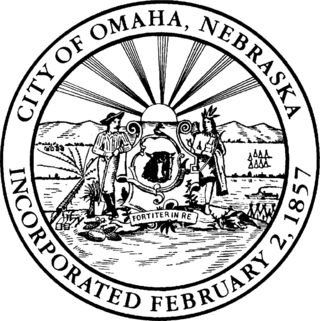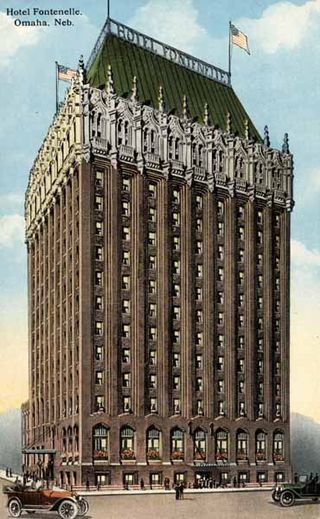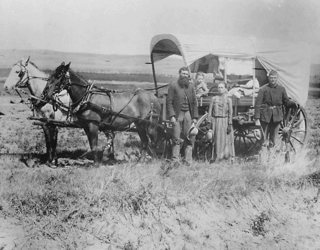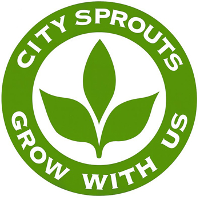There are numerous community gardens in the U.S. state of Nebraska. A community garden is a piece of land collectively farmed by several people and may be created by local residents purchasing or taking over a vacant plot, or by an institution such as a church donating land to the community. In Nebraska many of the community gardens are to be found in or near the principal cities of Omaha and Lincoln, [1] although examples may also be found in smaller communities such as Grand Island.
Dundee Community Garden is in the Dundee neighborhood of Omaha. The garden site is located at 4902 Underwood. [2] Dundee Community Garden is one of the most notable. [3] [ dead link ] Dundee Community Garden is a member of the American Community Gardening Association. [4] The garden was founded on a vacant lot in 2009 by a group of local residents. [5] In early 2013, Dundee Community Garden Inc., received non-profit status as a 501(c)(3) organization. [6] After a fundraising campaign, which included support from the Sherwood Foundation and the Peter Kiewit Foundation, on 15 May 2013, DCG purchased the land from the previous owner. [7]
The Big Garden began in 2005. Initially funded by the USDA's Community Food Project, the Big Garden had a goal of creating 12 community gardens in three years. Five years later the Big Garden included 26 gardens in the metro-Omaha area and added a sister project, the Big Rural Garden, in Southeast Nebraska. Today, the Big Garden is a network of over 100 community gardens in metro-Omaha and rural and semi-rural communities in Nebraska, Kansas, and Iowa---and growing!
The second annual "Tour de Gardens" was held in Omaha in 2014 with approximately 100 bicycle riders visiting 8 gardens and a root facility. [8]
| Name | Location |
|---|---|
| Benson Community Garden | 1302 North 60th Street |
| The Big Garden | (multiple locations) |
| Big Muddy Urban Farm | 33rd and California, 35th and Cass, 18th and Fowler, 48th and Sahler |
| City Sprouts | 4002 Seward Street |
| Earth Shelter Community Garden | 65th and Ames |
| Farnam Farm | 49th Street and Farnam Street |
| Gifford Park Community Garden | 3416 Cass Street |
| Hands to Harvest Community Garden | 1113 South 31st Street |
| New Omaha Garden Park | 495 S. 192nd, Elkhorn |
| Root Down Community Garden | 32nd and Webster |
| Sherman Community Center Garden | 5701 North 16th Street |
| Springbrook Community Garden | 7322 North 76th Street |
Lincoln, Nebraska has 13 community gardens as of May 2014. All of these are full and the organizing institution, Community CROPS (Combining Resources, Opportunities, and People for Sustainability), which was founded in 2003 with one garden, is now looking for new sites around Lincoln. [9] In addition to the community gardens, CROPS also runs a training farm, a community supported agriculture program, and a regular stand at a local farmers' market. [10]
| Name | Location |
|---|---|
| 46th Street | 46th Street and Pioneers Boulevard |
| Antelope | Sumner Street and Normal Boulevard |
| Southern Heights | S 40th Street and Old Cheney Road |
| 1st and L | 1st and L Street |
| Northeast Church | Adams Street |
| Oak Lake Church | N 1st Street |
| Peter Pan Park | Peter Pan Park |
| Mustard Seed | N 70th Street |
| 1st Presbyterian | S 18th Street |
| Southminster | Otoe Street |
| 14th and Hudson | S 14th Street and Hudson Street |
A new community garden in Grand Island called the Cherry Street Community Garden was started in 2014, with 10 by 10 feet (3.0 m × 3.0 m) plots available for rent, supported by a city councilwoman and the adjacent Cherry Street Apartments complex. [11]

Lincoln is the capital of the U.S. state of Nebraska and the county seat of Lancaster County. The city covers 100.4 square miles (260.035 km2) and had an estimated population of 294,757 in 2023. It is the state's second-most populous city and the 71st-largest in the United States. Lincoln is the economic and cultural anchor of the Lincoln Metropolitan and Lincoln-Beatrice Combined Statistical Areas, home to 361,921 people.

Omaha is the most populous city in the U.S. state of Nebraska and the county seat of Douglas County. It is located in the Midwestern United States along the Missouri River, about 10 mi (15 km) north of the mouth of the Platte River. The nation's 40th-most populous city, Omaha had a population of 486,051 as of the 2020 census. It is the anchor of the eight-county Omaha–Council Bluffs metropolitan area, which extends into Iowa and is the 58th-largest metro area in the United States, with a population of 967,604. Furthermore, the greater Omaha–Council Bluffs–Fremont combined statistical area had 1,004,771 residents in 2020.

Scouting in Nebraska dates from the 1910s to the present day. There are three Boy Scouts of America local councils in Nebraska. All of Nebraska lies within Central Region, except for Sioux, Scotts Bluff, Banner, Kimball, Cheyenne, Dawes, Box Butte, Morrill, Cheyenne, Sheridan, Garden, Deuel and Grant counties, as part of Western Region.
The Music of Nebraska has included a variety of country, jazz, blues, ragtime, rock, and alternative rock musicians. Though many cities and towns across the state have active musical scenes, artists from Omaha and Lincoln have a particularly important musical legacy.

The Dundee–Happy Hollow Historic District is located west of Midtown Omaha, Nebraska. It covers the area between Harney Street on the south, Hamilton Street on the north, Happy Hollow Boulevard on the west, and 46th Street on the east. The "heart" of Dundee is located at 50th and Underwood Avenue in Omaha, Nebraska, United States. It was founded in 1880 and annexed into the city in 1915. Dundee is home to Warren Buffett and nationally syndicated editorial cartoonist Jeff Koterba and was the hometown of filmmaker Alexander Payne. Actor Henry Fonda additionally lived in the Dundee neighborhood.

The Omaha World-Herald is a daily newspaper in the midwestern United States, the primary newspaper of the Omaha-Council Bluffs metropolitan area.

A community garden is a piece of land gardened or cultivated by a group of people individually or collectively. Normally in community gardens, the land is divided into individual plots. Each individual gardener is responsible for their own plot and the yielding or the production of which belongs to the individual. In collective gardens the piece of land is not divided. A group of people cultivate it together and the harvest belongs to all participants. Around the world, community gardens exist in various forms, it can be located in the proximity of neighborhoods or on balconies and rooftops. Its size can vary greatly from one to another. Depending on the location can determine the price of community gardens

The Nebraska State Fair is the state fair of the U.S. state of Nebraska. It is held annually in Grand Island, approximately 100 miles west of the state capital of Lincoln, which hosted the fair until 2010. The fair usually runs for 11 days, and since the early 1990s it has ended on Labor Day.

The City Council of Omaha, Nebraska, is elected every four years on a nonpartisan basis. The next election will occur in 2025. Omaha has a strong mayor form of government. Members are elected by district. Currently seven city council districts are represented across the City of Omaha.

The history of Omaha, Nebraska, began before the settlement of the city, with speculators from neighboring Council Bluffs, Iowa staking land across the Missouri River illegally as early as the 1840s. When it was legal to claim land in Indian Country, William D. Brown was operating the Lone Tree Ferry to bring settlers from Council Bluffs to Omaha. A treaty with the Omaha Tribe allowed the creation of the Nebraska Territory, and Omaha City was founded on July 4, 1854. With early settlement came claim jumpers and squatters, and the formation of a vigilante law group called the Omaha Claim Club, which was one of many claim clubs across the Midwest. During this period many of the city's founding fathers received lots in Scriptown, which was made possible by the actions of the Omaha Claim Club. The club's violent actions were challenged successfully in a case ultimately decided by the U.S. Supreme Court, Baker v. Morton, which led to the end of the organization.

The culture of Omaha, Nebraska, has been partially defined by music and college sports, and by local cuisine and community theatre. The city has a long history of improving and expanding on its cultural offerings. In the 1920s, the Omaha Bee newspaper wrote, "The cultural future of Omaha seems as certain of greatness as the commercial future... The symphony orchestra, the Art institute, the Community Playhouse and other organizations are on firm foundations and Omaha is destined to be not only a bigger, but a better city, both financially and culturally." Reviewing Omaha's contemporary arts scene in 2007, the New York Times hailed the city as having "a kind of cultural awakening".

The history of the U.S. state of Nebraska dates back to its formation as a territory by the Kansas–Nebraska Act, passed by the United States Congress on May 30, 1854. The Nebraska Territory was settled extensively under the Homestead Act of 1862 during the 1860s, and in 1867 was admitted to the Union as the 37th U.S. state. The Plains Indians are the descendants of a long line of succeeding cultures of indigenous peoples in Nebraska who occupied the area for thousands of years before European arrival and continue to do so today.

Transportation in Omaha, Nebraska, includes most major modes, such as pedestrian, bicycle, automobile, bus, train and airplane. While early transportation consisted of ferries, stagecoaches, steamboats, street railroads, and railroads, the city's transportation systems have evolved to include the Interstate Highway System, parklike boulevards and a variety of bicycle and pedestrian trails. The historic head of several important emigrant trails and the First transcontinental railroad, its center as a national transportation hub earned Omaha the nickname "Gate City of the West" as early as the 1860s.

Community gardens in the United States benefit both gardeners and society at large. Community gardens provide fresh produce to gardeners and their friends and neighbors. They provide a place of connection to nature and to other people. In a wider sense, community gardens provide green space, a habitat for insects and animals, sites for gardening education, and beautification of the local area. Community gardens provide access to land to those who otherwise could not have a garden, such as apartment-dwellers, the elderly, and the homeless. Many gardens resemble European allotment gardens, with plots or boxes where individuals and families can grow vegetables and flowers, including a number which began as victory gardens during World War II. Other gardens are worked as community farms with no individual plots at all, similar to urban farms.

The 2014 U.S. House of Representatives elections in Nebraska were held on Tuesday, November 4, 2014, to elect 3 members of the U.S. House of Representatives from the state of Nebraska, one from each of the state's three congressional districts. The elections coincided with the elections of other federal and state offices, including the governor of Nebraska and a United States senator. Primary elections to determine candidates in the general election were held on Tuesday, May 13, 2014. The members elected at this election will serve in the 114th Congress.

City Sprouts is a community garden, urban farm, and educational resource center in the Orchard Hill neighborhood of Omaha, Nebraska. Founded in 1995, City Sprouts is the oldest community garden in the city. The organization is registered as a 501(c)(3) not-for profit entity.
There are over 550 community gardens on city property, over 745 school gardens, over 100 gardens in land trusts, and over 700 gardens at public housing developments throughout New York City. The community gardens are maintained by city residents who steward the often underutilized land. The community garden movement in NYC began in the Lower East Side during the disrepair of the 1960s on vacant, unused land. These first gardens were tended without governmental permission or assistance.

The COVID-19 pandemic in Nebraska is an ongoing viral pandemic of coronavirus disease 2019 (COVID-19), a novel infectious disease caused by severe acute respiratory syndrome coronavirus 2 (SARS-CoV-2). As of March 2, 2022, there have been 475,690 confirmed cases and 3,986 deaths.